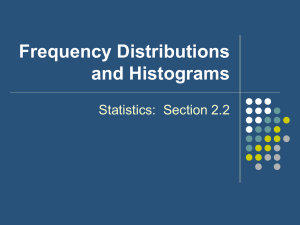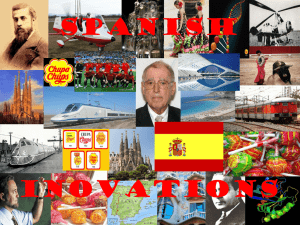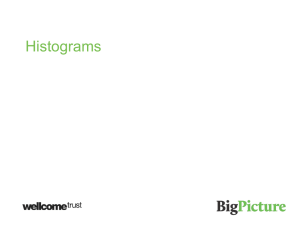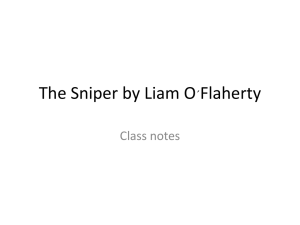1 - HEPG
advertisement
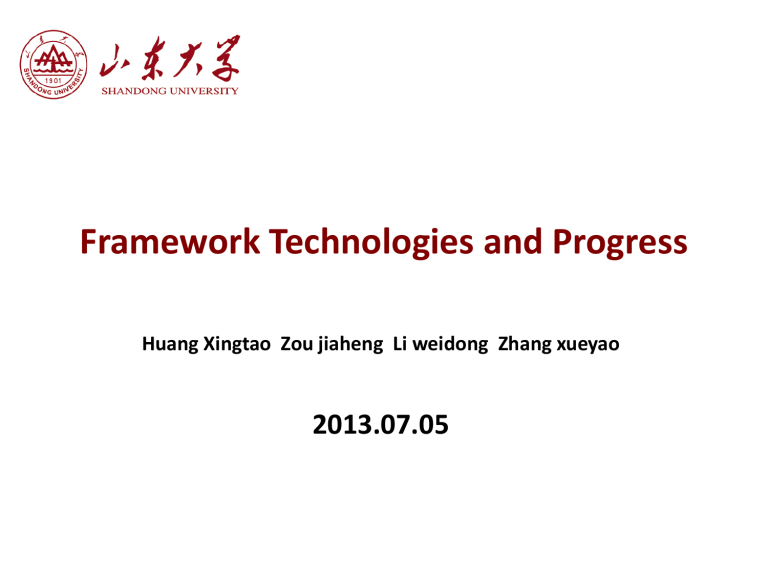
Framework Technologies and Progress Huang Xingtao Zou jiaheng Li weidong Zhang xueyao 2013.07.05 What’s a Framework? Framework Definition – A skeleton of an application into which developers plug in their – code and provides most of the common functionalities. Provide and define standard interfaces between components. Framework Benefits – Better specifications of what needs to be done – Better understanding of the system. – Low coupling between concurrent developments – Smooth integration and organization of the development. – Robustness, resilient to change (change-tolerant). – Fostering code re-use Offline Tutorial II (X.T. Huang , SDU) 1 Software Organization Framework Basic libraries (such as Geant4, Root, Python, Openscientist, CLHEP, etc) Foundation Libraries Offline Tutorial II (X.T. Huang , SDU) 2 Analysis interfaces, data exchange and persistency mechanisms, interactivity Trigger Provides basic services, common Simulation components (Algorithms, Services, etc) Reconstruction Applications using framework 几个离线软件系统的构成 Gaudi Object Diagram Converter Converter Converter Application Manager Message Service JobOptions Service Particle Prop. Service Other Services Event Data Service Persistency Service Data Files Transient Event Store Algorithm Algorithm Algorithm Detec. Data Service Transient Detector Store Persistency Service Data Files Histogram Service Transient Histogram Store Persistency Service Data Files 4 Advantages of Gaudi Clear separation between data and algorithms Clear separation between persistent data and transient data Data Store-centered architectural style Encapsulated User code localized in few specific places – Algorithms and Converters Run-time loading of components (dynamic libraries). – addition of new components requires minimal recompilation All components with well defined interfaces and as generic as possible Offline Tutorial II (X.T. Huang , SDU) 5 Disadvantages of Gaudi Multi-layers structure Too many third-party software or tools Relatively Slower Not suitable for non-accelerator experiments ,especially events with time or space correlation Light-weighted Framework (LAF) was designed and used for analysis. 13-1-6 Beijing, CHINA for Review 6 New Experiments and New Framework JUNO and LHAASO Experiment under R&D in China – JUNO performs very high precision measurement – LHAASO is very large scale experiment – Both are non-accelerator experiments – NuWa users’ experience shows that Gaudi is not suitable – Met the “similar” situation with BESIII in 2001 ,but huge difference Fortran , C , C++ belle (BASF), LHCb(Gaudi) , Babar or new one Finally Gaudi was chosen!! – Lots of work has been done! General Design Principle 事 例 产 生 器 探 测 器 模 拟 数 据 刻 度 事 例 重 建 物 理 分 析 事 例 产 生 器 JUNO 探 测 器 模 拟 数 据 刻 度 事 例 重 建 物 理 分 析 LODESTAR … SNiPER AIDA CLHEP GCCXML ROOT Geant4 SNiPER : Software for Non-collider Physics ExpeRiments LODESTAR : LHAASO Offline Data Processing Software Framework …… Requirements for SNiPER Learning from Gaudi – – – – – – – Data store centered architectural style algorithms as data producers and consumers Separation between data and algorithms decease coupling and better for team development User code encapsulated in few specific places Algorithm, Service, DataObject Modularity Structure Run-time loading of components (dynamic libraries). Flexible execution control of algorithms Object I/O Capability to read/write C++ object. Independent of specific data models Programmable script parser for the control (Lin Tao , Xia xin) Separation between “transient” and “persistent” representations of data??? based on the difference in different processing steps. New requirements – 13-1-6 Interface to distributed computing ( Zou Jiaheng ) Parallel processing Data file access over WAN (i.e. GRID) Beijing, CHINA for Review 9 Kernel Structure of SNiPER OptionParser/PropertyMgr: run time parameters configuration Algorithms: data calculations Services: other useful functionalities OptionParser PropertyMgr setOption(name, value) SniperMgr initialize() run() finilize() AlgMgr algs initialize() execute() finilize() initialize() execute() finilize() SvcMgr initialize() finilize() IAlgorithm svcs IService initialize() finilize() 10 Algorithm and Service Management IAlgorithm ConcreteAlg name() Concrete Algorithm: 1. 2. 模块化,可动态加载 仅通过接口与框架通信 3. 每个特定类型算法可有一个或多个实例,通过 name进行区分 4. 可按配置顺序生成算法序列,支持嵌套、分支 等控制流程 Concrete Service: • 具有与算法1-3相同特性 • 可通过name在SNiPER内任意位置获取所需的 service实例 IService ConcreteSvc name() 11 Algorithm and Data 数据与算法分离 Input Service Algorithm 1 Algorithm 2 DISK DATA in MEMORY Algorithm 3 Output Service DISK • 便于不同算法间分享数据 • 算法专注于数据的计算处理,与I/O解耦 12 DataModel DataObj Header header context readout_map header RawReadout Readout setHeader() McReadout RecReadout Header: 事例整体信息,id、detector、time等 Readout: 具体分支信息 Header中的readout_map对普通用户隐藏 13 DataBuffer DataBuffer current() bigin() end() size() seek(int i) • 对普通用户仅提供只读接口 • 仅做为数据容器,与I/O解耦 只对头、尾进行增删操作,内部使用deque head1 head2 head3 用户经由header间接访问, 且有随机性(lazy load), 使用list head4 head5 head6 head7 head8 rec1 rec2 rec5 rec6 MC2 MC5 MC7 MC8 rec8 考虑到GenEvent等类型与Header可能有一对多的对应关系,为降低内存 数据维护难度,buffer中可保存“智能指针” 14 Event Buffer Current event Other events Event buffer 专为对“时间关联事例”分析进行的设计 Exe Num EvtNum: 0 1 2 3 4 5 6 7 0 1 2 3 4 5 6 7 15 运行时序示意图 SniperMgr syncData BufferMgr DataWriter Algorithms write read loop execute get put DataReader 每次事例循环开始时同步内存与磁盘数据(I/O) 算法通过BufferMgr接口完成内存数据的存取 16 Short Summary Brief introduction to Framework Decide to design New Non-Gaudi based Framework One working version of SNiPER exists – several main functionalities have been implmented SniperMgr Algorithm interface and management Service interface and management configuration interface one example is provided – some need to be further optimized and discussed today In-memory data management Event data model persistency mechanism parallel processing python configuration Interface to Data base, Geometry and so on Gaudi heavily relies on ROOT FairRoot:developed by GSI-IT Start testing the VMC concept for CBM Panda decided to join-> FairRoot: same Base package for different experiments R3B joined 2004 2006 2010 First Release of CbmRoot MPD (NICA) start also using FairRoot ASYEOS joined (ASYEOSRoot) 22.05.12 Florian Uhlig CHEP 2012, New York EIC (Electron Ion Collider BNL) EICRoot 2011 GEM-TPC separated from PANDA branch (FOPIRoot) 19 FairRoot for • Simulation,reconstruction ,Data analysis • Fully based on the ROOT Planned Start in 2016 ! typedef std::map< std::string, TObject * > StoreObjMap typedef std::map< std::string, TClonesArray * > StoreArrayMap ROME Root based Object oriented Midas Extension • Tool for Event based Data Analysis • Fully Object Oriented • Root based • Full connection to the Midas Environment • Online and Offline • Based on Tasks, Containers and Folders for a good Data and Program Structure • Experiment independent Base Classes • Experiment dependent Classes are generated out of simple XML-Files • The Users write only experiment specific code (physics) • Administrative code is implemented in the generated code • Self Documenting Code • Shuei Self Linking Project YAMADA @ MEG review meeting, 2 31 ROME Objects Folders Tasks • Objects, where data is stored in • Tasks are objects, which provides actions • Stores the data of one detector (or sub detector) component • They make calculations • Hierarchically arranged • Data inside of Folders is structured • Store and read data in folders • Fill trees and histograms • Hierarchically arranged • Task also own histograms Trees • Data Objects : only written, never read Histograms • Used to write data on files • Graphical Data Objects : only written • Belong to one Task Steering Parameters • Task steering • Framework steering Shuei YAMADA @ MEG review meeting, 2 32 Interconnections Disk Read (any Format) (Input) Read Histograms Histograms Histograms Fill Tasks Tasks Tasks Fill Folders Histograms Histograms Histograms Fill Histograms Histograms Histograms Flag Read Shuei YAMADA @ MEG review meeting, 2 Trees Trees Trees Write (ROOT) 33 Disk (Output) Facts show us ROOT becomes more and more popular and powerful From generator to analysis, most processes data can be saved into ROOT It is better to have as same as possible event data definition between transient and Persistency – easy implementation of I/O Design of Event Data Model based on ROOT – Data Object inherits from Tobject Event Data Model based on ROOT Navigation functions reply on Header Objects. Pros : straightforward cons: no general enough Dyb uses RegistrationSequnce which is separately from headers Tags for fast review Purpose of tag is to support fast review events and decide whether or not to further read more data into Store. Layout of Store Front Store std::deque<Tobject* > frontStore Back Store std::map< std::string, std::list<Tobject* > > backStore Object Access and I/O Data Store is used to manage the layout of TObjects – support access to Data Store with path or type Data objects could be written to and read from Data Store with the streamers of these classes which will be automatically generated and included in the dictionary library. Manipulation of this Data Store: – Filling – Reading – Trimming – Writing Need further design and implement Discussion Further collect requirements of framework – in form of Use Case Study Discuss and finalize the Data Model Design – – – – data structure data navigation data storage implementation similar with GOD or coded Optimize design of In-Memory Management – – – Buffer mechanism Adopting ROOT I/O Other functionalities discussion – – – – Job configuration ( python ) User interfaces (Algorithm, Services, Tools……) structure of the whole offline softer system …… More inputs More thinking More discussion Thanks a lot! Art art is a generic C++-based modular analysis framework, for use from generator-level or DAQ event building through simulation, production and user analysis. – g-2 ,Mu2e,NOνA, LArSoft(μBooNE,ArgoNeuT, LBNE) art grew out of and forked from CMS in 2010 Developer has been involved with frameworks: – DØ, BTeV, CMS and MiniBooNE. art plans to support parallel processing of independent events as well as to permit parallel processing within events Art architecture
